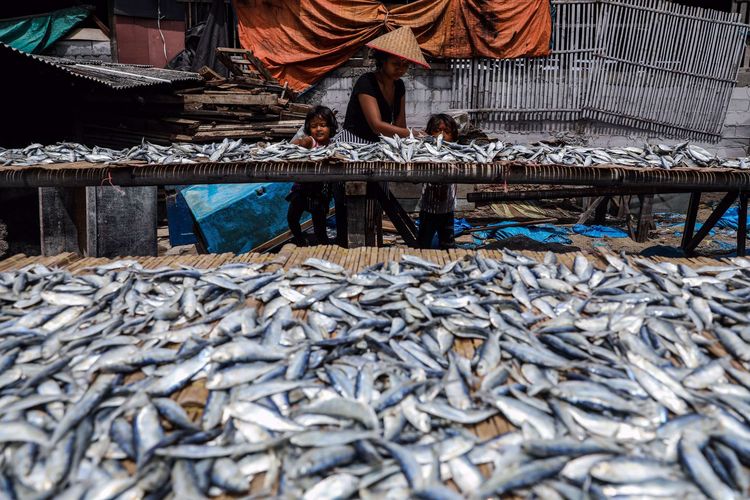JAKARTA, KOMPAS.com – Salted fish has long been an inseparable part of the culinary traditions of Indonesian society.
As a simple side dish that is rich in flavor, salted fish is often eaten with various accompanying dishes, such as rice, shrimp paste chili sauce, tofu, tempeh, and tamarind vegetables.
There is an abundance of variety, from salted peda fish, anchovies, mackerel, to jambal.
However, not everyone likes salted fish. Some avoid it because of its strong salty taste or the stigma that it is considered “not classy.”
Even so, the facts show that salted fish has still been loved by people from various social strata, even since ancient times.
Also read: Salted Fish, a Symbol of Togetherness and Pride of the Indonesian Nation
 Workers flatten fish being dried in the sun at the fish processing center, Muara Angke, North Jakarta, Thursday (22/10/2020). The price of a number of salted fish commodities has increased due to decreasing supply and the arrival of the rainy season which lengthens the drying time for fish.
Workers flatten fish being dried in the sun at the fish processing center, Muara Angke, North Jakarta, Thursday (22/10/2020). The price of a number of salted fish commodities has increased due to decreasing supply and the arrival of the rainy season which lengthens the drying time for fish.Is there evidence that salted fish has existed since ancient times?
An interesting fact is that salted fish is not a new food in the archipelago. In her book, “Markets in Java: The Ancient Mataram Period, VIII-XI Century AD,” archaeologist Titi Surti Nastiti revealed that salted fish had been known to Javanese people since the 8th century AD.
According to Titi, salted fish – which in the Pangumulan A Inscription (824 Saka/902 AD) is called Grih or fine—was one of the commodities traded in Javanese markets at that time. Types of salted fish include mackerel, snapper, and mackerel.
Term Grih or fine also recorded in the Rukam Inscription (829 Saka/907 AD). Salted fish is used as a dish in the sacred land designation ceremony (sima).
This shows that salted fish was not only a daily food, but also part of the important traditions and rituals of the Ancient Mataram people.
Also read: 8 delicious ways to cook salted fish, from buying tips to frying
 Book Market in Java Period: Ancient Mataram VIII-XI Century AD
Book Market in Java Period: Ancient Mataram VIII-XI Century ADWhat Keeps Salted Fish Existing?
After more than 13 centuries, salted fish is still part of Indonesian people’s lives. Its existence, which is easy to find in traditional markets and vegetable stalls in big cities, reflects the longevity of this culinary delight.
Salted fish also plays an important role in the community’s economy, especially as a trading commodity.
Even though it is often associated with lower class food, salted fish actually reflects the cultural resilience and creativity of Indonesian people in processing seafood.
Also read: Recipe for sautéed kale with sliced shrimp paste, add salted fish
 Salted fish traders serve buyers at the Ciamis Regency Traditional Market, West Java, Friday (28/7/2017). Salted fish traders admit that various types of salted fish have experienced an average price increase of around Rp. 1,000 to Rp. 2,000 due to the price of salt which is currently increasing and it is difficult to obtain the raw material for making salted fish.
Salted fish traders serve buyers at the Ciamis Regency Traditional Market, West Java, Friday (28/7/2017). Salted fish traders admit that various types of salted fish have experienced an average price increase of around Rp. 1,000 to Rp. 2,000 due to the price of salt which is currently increasing and it is difficult to obtain the raw material for making salted fish. How Does Salted Fish Represent Local Culture?
The long history of salted fish proves that this culinary dish is not just food. It represents the social, economic and cultural dynamics of Indonesian society from time to time.
In Javanese tradition, the term irritating for salted fish and beef jerky for dried fish is a linguistic trace that enriches the culinary history of the archipelago.
Despite the stigma attached to it, salted fish has proven its position as one of Indonesia’s culinary icons.
With all its simplicity, salted fish has become a symbol of continued tradition, local identity and innovation that is deeply rooted in people’s lives.
Also read: How to fry salted fish so that it is crispy and not tough
Listen breaking news And selected news we’re right on your phone. Choose your favorite news channel to access Kompas.com WhatsApp Channel: https://www.whatsapp.com/channel/0029VaFPbedBPzjZrk13HO3D. Make sure you have installed the WhatsApp application.






